A current-carrying closed Loop in the form of a right isosceles triangle ABC is placed in xy plane in a uniform magnetic field acting along the y-axis as shown in the figure. If the magnetic force on the arm AC is , then force on the arm BC and AB are respectively
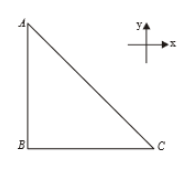
1. zero, zero
2. \(-\vec {F}\) and zero
3. \(\vec {F}\) and \(-\vec {F}\)
4. \(\vec {F}\) and zero
समकोण समद्विबाहु त्रिभुज ABC के रूप में एक धारावाही बंद लूप को Y-अक्ष के अनुदिश आरोपित एकसमान चुंबकीय क्षेत्र में XY -तल में चित्र में दर्शाए गए अनुसार स्थित है। यदि भुजा AC पर चुंबकीय बल है, तब भुजा BC और AB पर आरोपित बल क्रमशः है -
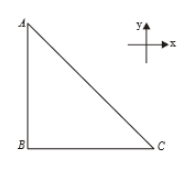
1. शून्य, शून्य
2. \(-\vec {F}\) और शून्य
3. \(\vec {F}\) और \(-\vec {F}\)
4. \(\vec {F}\) और शून्य
When a proton is released from rest in a room, it starts with an initial acceleration towards the east. When it is projected towards the north with a speed , it moves with initial acceleration towards east. The electric and magnetic fields in the room are-
1. \(\frac{\mathrm{Ma}_0}{\mathrm{e}} \text {west, }\frac{\mathrm{Ma}_0}{\mathrm{ev}_0} \mathrm{up}
\)
2. \(\frac{\mathrm{Ma}_0}{\mathrm{e}} \text { west,} \frac{2 \mathrm{Ma}_0}{\mathrm{ev}_0} \text {down}
\)
3. \(\frac{\mathrm{Ma}_0}{\mathrm{e}} \text {east, } \frac{2 \mathrm{Ma}_0}{\mathrm{ev}_0} \text { down}
\)
4. \(\frac{\mathrm{Ma}_0}{\mathrm{e}} \text { east, }\frac{2 \mathrm{Ma}_0}{\mathrm{ev}_0} \text {up}\)
जब एक प्रोटॉन को कमरे में विरामावस्था से मुक्त किया जाता है, तब यह पूर्व की ओर प्रारंभिक त्वरण से गति करता है। जब इसे वेग से उत्तर की ओर प्रक्षेपित किया जाता है, तब यह प्रारंभिक त्वरण से पूर्व की ओर गति करता है। कमरे में विद्युत और चुंबकीय क्षेत्र क्रमश: हैं -
1. \(\frac{\mathrm{Ma}_0}{\mathrm{e}}
\) पश्चिम , \(\frac{\mathrm{Ma}_0}{\mathrm{ev}_0}\)ऊपर
2. \(\frac{\mathrm{Ma}_0}{\mathrm{e}}
\)पश्चिम , \(\frac {2Ma_0}{ev_0}\)नीचे
3. \(\frac{\mathrm{Ma}_0}{\mathrm{e}}
\)पूर्व, \(\frac {2Ma_0}{ev_0}\)नीचे
4. \(\frac{\mathrm{Ma}_0}{\mathrm{e}}
\) पूर्व, \(\frac {2Ma_0}{ev_0}\)ऊपर
The magnetic dipole moment of the given loop is
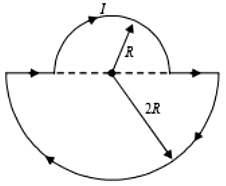
1. \(\frac{5}{2} \pi \text R^2 \text I
\)
2. \(3 \pi \text R^2 \text I
\)
3. \(\frac{3}{2} \pi \text R^2 \text I
\)
4. \(5 \pi \text R^2 \text I\)
दिए गये लूप का चुंबकीय द्विध्रुव आघूर्ण है:
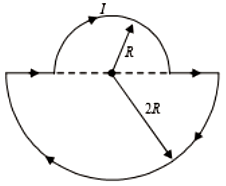
1. \(\frac{5}{2} \pi \text R^2 \text I
\)
2. \(3 \pi \text R^2 \text I
\)
3. \(\frac{3}{2} \pi \text R^2 \text I
\)
4. \(5 \pi \text R^2 \text I\)
The figure shows a particle of charge q and mass m moving with velocity v along the x-axis enters a region of the uniform magnetic field. The minimum value of v so that the charge q is deflected by an angle is
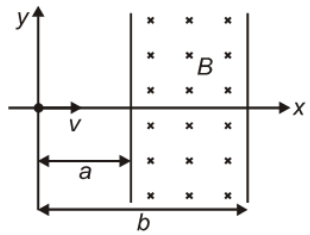
1. \(\frac{2 \mathrm{qBb}-\mathrm{a}}{\mathrm{m}}
\)
2. \(\frac{\mathrm{qBb}+\mathrm{a}}{2 \mathrm{~m}}
\)
3. \(\frac{\mathrm{qBb}-\mathrm{a}}{\mathrm{m}}
\)
4. \(\frac{\mathrm{qBb}}{2 \mathrm{~m}}\)
चित्र एक समान चुंबकीय क्षेत्र में x-अक्ष के अनुदिश v वेग से प्रवेश करने वाले q आवेश और m द्रव्यमान के एक कण को दर्शाता है। वेग v का न्यूनतम मान जिससे कण, के कोण से विक्षेपित होता है।
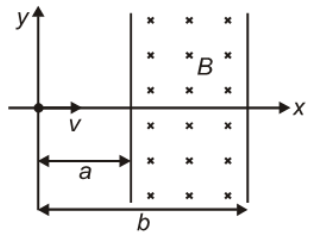
1. \(\frac{2 \mathrm{qBb}-\mathrm{a}}{\mathrm{m}}
\)
2. \(\frac{\mathrm{qBb}+\mathrm{a}}{2 \mathrm{~m}}
\)
3. \(\frac{\mathrm{qBb}-\mathrm{a}}{\mathrm{m}}
\)
4. \(\frac{\mathrm{qBb}}{2 \mathrm{~m}}\)
An infinitely long straight conductor is bent into the shape as shown in the figure. It carries a current of i ampere and the radius of the circular loop is r meter. Then the magnetic induction at its centre will be
1.
2.
3. Zero
4. Infinite
एक अनंत लंबाई के सीधे चालक तार को चित्र में दिखाई गई आकृति के अनुसार मोड़ा गया है। इसमें i ऐम्पियर की धारा प्रवाहित होती है और वृत्ताकार लूप की त्रिज्या r मीटर है। तब इसके केंद्र पर चुंबकीय क्षेत्र होगा-
1.
2.
3. शून्य
4. अनंत
In the following figure a wire bent in the form of a regular polygon of n sides is inscribed in a circle of radius a. Net magnetic field at centre will be
1.
2.
3.
4.
निम्नलिखित आकृति में एक तार a त्रिज्या वाले वृत्त से घिरे एक n भुजा के एक नियमित बहुभुज के रूप में मुड़ा हुआ है। केंद्र पर कुल चुंबकीय क्षेत्र होगा:
1.
2.
3.
4.
A part of a long wire carrying a current i is bent into a circle of radius r as shown in the figure. The net magnetic field at the centre O of the circular loop is

1.
2.
3.
4.
धारा i वाले लंबे तार का एक भाग त्रिज्या r के एक वृत्त के रूप में मुड़ा हुआ है जैसा कि चित्र में दिखाया गया है। वृत्ताकार लूप के केंद्र O पर कुल चुंबकीय क्षेत्र है:

1.
2.
3.
4.
A and B are two concentric circular conductors of centre O and carrying currents and as shown in the adjacent figure. If ratio of their radii is 1 : 2 and ratio of the flux densities at O due to A and B is 1 : 3, then the value of is

1.
2.
3.
4.
A और B समान केंद्र O वाले दो संकेंद्रित वृत्ताकार चालक हैं और जिनमें धाराएँ और प्रवाहित हो रही हैं जैसा कि आसन्न आकृति में दिखाया गया है। यदि उनकी त्रिज्या का अनुपात 1: 2 है और A और B के कारण O पर फ्लक्स घनत्व का अनुपात 1: 3 है, तब का मान है:

1.
2.
3.
4.
PQRS is a square loop made of uniform conducting wire the current enters the loop at P and leaves at S. Then the magnetic field will be
| 1. | Maximum at the centre of the loop |
| 2. | Zero at the centre of the loop |
| 3. | Zero at all points inside the loop |
| 4. | Zero at all points outside of the loop |
PQRS एकसमान चालक तार से निर्मित एक वर्गाकार लूप है, धारा लूप में P से प्रवेश करती है और S से निकलती है। तब चुंबकीय क्षेत्र होगा:
| 1. | लूप के केंद्र पर अधिकतम |
| 2. | लूप के केंद्र पर शून्य |
| 3. | लूप के अंदर सभी बिंदुओं पर शून्य |
| 4. | लूप के बाहर सभी बिंदुओं पर शून्य |
A proton and an particle enter a uniform magnetic field perpendicularly with the same speed. If proton takes 25 sec to make 5 revolutions, then the periodic time for the particle would be :
1. 50 sec
2. 25 sec
3. 10 sec
4. 5 sec
एक प्रोटॉन और एक कण एक समान गति से एक समान चुंबकीय क्षेत्र में लंबवत् रूप से प्रवेश करते हैं। यदि प्रोटॉन 5 घूर्णन करने के लिए लेता है, तब कण के लिए आवर्त काल कितना होगा:
1. 50
2. 25
3. 10
4. 5











